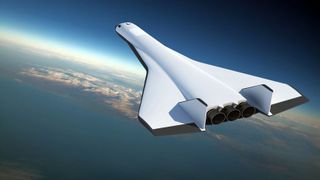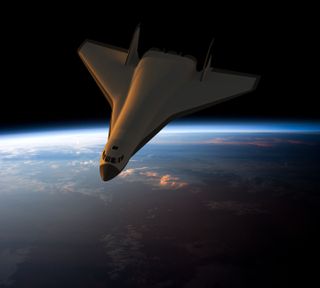
There's a new private space plane in the works.
Washington-based Radian Aerospace emerged from "stealth mode" Wednesday (Jan. 19), announcing that it has raised $27.5 million in seed funding. The money will aid the development of Radian One, a crew-carrying orbital space plane that Radian hopes will transform spaceflight as well as travel here on Earth.
"We believe that widespread access to space means limitless opportunities for humankind," Radian CEO and co-founder Richard Humphrey said in a statement.
"Over time, we intend to make space travel nearly as simple and convenient as airliner travel," Humphrey said. "We are not focused on tourism; we are dedicated to missions that make life better on our own planet, like research, in-space manufacturing and terrestrial observation, as well as critical new missions like rapid global delivery right here on Earth."
Space planes: Evolution of the winged spaceship (infographic)

Radian One is an ambitious vehicle. It's designed to launch and land horizontally on a runway, unlike NASA's old space shuttle orbiters, which landed horizontally but lifted off vertically with the help of solid rocket boosters. (Radian One will get some takeoff help, too, from a sled that will accelerate the vehicle on the runway.)
The new space plane will be fully reusable and capable of spending up to five days in orbit, according to its newly unveiled specifications page. Rapid turnaround time is also part of the plan: Radian aims eventually to refly vehicles as soon as 48 hours after touchdown.
Get the Space.com Newsletter
Breaking space news, the latest updates on rocket launches, skywatching events and more!
Radian One is designed to carry people and payloads to and from orbit. But the space plane could also do a lot of work here on Earth; the plane will be able to deliver up to 5,000 pounds (2,270 kilograms) anywhere on the planet in less than an hour, Radian Aerospace representatives said.
Radian has not revealed many other details about the space plane — for example, its size, how many passengers it will be able to carry and when it's expected to start flying. Radian representatives said in Wednesday's press release that it has signed launch services agreements with a variety of private companies and government agencies, but it did not name any of those customers.
The new round of seed funding was led by the venture capital fund Fine Structure Ventures. A number of other investors chipped in, including Exor, The Venture Collective, Helios Capital, SpaceFund, Gaingels, The Private Shares Fund, Explorer 1 Fund and Type One Ventures, Radian representatives said.
"On-demand space operations is a growing economy, and I believe Radian's technology can deliver on the right-sized, high-cadence operations that the market opportunity is showing," Dylan Taylor, chairman and CEO of Voyager Space and an early personal investor in Radian, said in the same statement.
"I am confident in the team working at Radian and look forward to cheering them along in this historical endeavor," added Taylor, who recently flew to suborbital space aboard Blue Origin's New Shepard vehicle.
Mike Wall is the author of "Out There" (Grand Central Publishing, 2018; illustrated by Karl Tate), a book about the search for alien life. Follow him on Twitter @michaeldwall. Follow us on Twitter @Spacedotcom or on Facebook.
Join our Space Forums to keep talking space on the latest missions, night sky and more! And if you have a news tip, correction or comment, let us know at: community@space.com.

Michael Wall is a Senior Space Writer with Space.com and joined the team in 2010. He primarily covers exoplanets, spaceflight and military space, but has been known to dabble in the space art beat. His book about the search for alien life, "Out There," was published on Nov. 13, 2018. Before becoming a science writer, Michael worked as a herpetologist and wildlife biologist. He has a Ph.D. in evolutionary biology from the University of Sydney, Australia, a bachelor's degree from the University of Arizona, and a graduate certificate in science writing from the University of California, Santa Cruz. To find out what his latest project is, you can follow Michael on Twitter.
Most Popular


